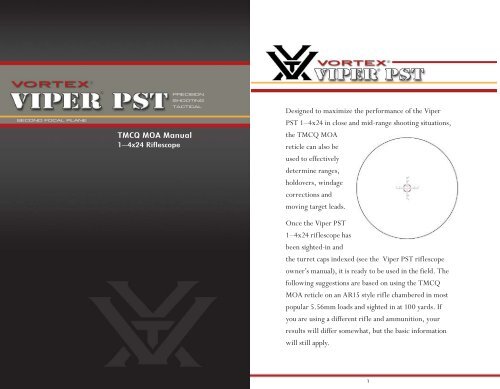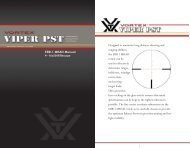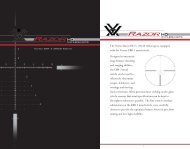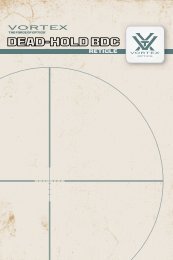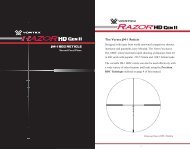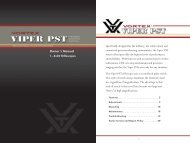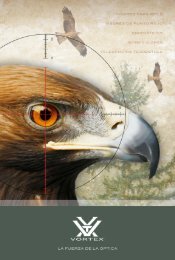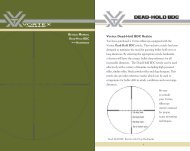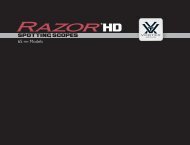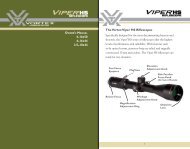Vortex TMCQ MOA reticle manual - EuroOptic.com
Vortex TMCQ MOA reticle manual - EuroOptic.com
Vortex TMCQ MOA reticle manual - EuroOptic.com
Create successful ePaper yourself
Turn your PDF publications into a flip-book with our unique Google optimized e-Paper software.
SECOND FOCAL PLANE<br />
<strong>Vortex</strong> EBR-1 <strong>MOA</strong> Reticle<br />
PRECISION<br />
SHOOTING<br />
TACTICAL<br />
<strong>TMCQ</strong> <strong>MOA</strong> Manual<br />
1–4x24 Riflescope<br />
Designed to maximize the performance of the Viper<br />
PST 1–4x24 in close and mid-range shooting situations,<br />
the <strong>TMCQ</strong> <strong>MOA</strong><br />
<strong>reticle</strong> can also be<br />
used to effectively<br />
determine ranges,<br />
holdovers, windage<br />
corrections and<br />
moving target leads.<br />
Once the Viper PST<br />
1–4x24 riflescope has<br />
been sighted-in and<br />
the turret caps indexed (see the Viper PST riflescope<br />
owner’s <strong>manual</strong>), it is ready to be used in the field. The<br />
following suggestions are based on using the <strong>TMCQ</strong><br />
<strong>MOA</strong> <strong>reticle</strong> on an AR15 style rifle chambered in most<br />
popular 5.56mm loads and sighted in at 100 yards. If<br />
you are using a different rifle and ammunition, your<br />
results will differ somewhat, but the basic information<br />
will still apply.<br />
1
Using at Close Ranges<br />
At short range distances inside of 25 yards, maximum<br />
performance will <strong>com</strong>e from using the PST 1–4x24<br />
riflescope set down to lowest 1x magnification and shooting<br />
with both eyes open using the heavy outer circle and<br />
illuminated center crosshair dot to quickly center the target.<br />
On most centerfire applications, actual point-of-impact will<br />
be just below the crosshair intersection—typically 1–2 inches<br />
low from 0–25 yards.<br />
Using at Intermediate Ranges<br />
For distances of 50–175 yards, more magnification<br />
may be used if desired and main crosshairs should<br />
still be used in a dead-on hold. On most centerfire<br />
applications, point-of-impact will typically be .2 inches<br />
below the crosshair intersection at 50 yards, dead on at<br />
100 yards and 2.4 inches below crosshair intersection<br />
by 175 yards.<br />
2 3
Using at Long Ranges<br />
Once distances approach 200 yards and beyond, the<br />
<strong>reticle</strong> subtension lines can be utilized to <strong>com</strong>pensate for<br />
bullet drop. If necessary, <strong>reticle</strong> subtensions can also be<br />
used to help estimate range.<br />
<strong>TMCQ</strong> Reticle<br />
<strong>MOA</strong> Subtensions<br />
Numbers refer to <strong>MOA</strong>s.<br />
Crosshair thickness subtends .2 moa.<br />
Note: When used in the second focal plane PST 1–4x24<br />
riflescope, the <strong>MOA</strong> subtensions listed in the diagram are<br />
only valid at the 4x magnification. On these riflescopes,<br />
all ranging and holdover corrections using the <strong>reticle</strong><br />
subtensions should be done at 4x.<br />
<strong>MOA</strong> Adjustments<br />
The <strong>TMCQ</strong> <strong>MOA</strong> <strong>reticle</strong> is based on minute-of-angle<br />
(<strong>MOA</strong>) subtensions. Many shooters are very familiar<br />
with the <strong>MOA</strong> system used in hunting riflescopes.<br />
<strong>MOA</strong> measurements are based on degrees and minutes<br />
(360 degrees in a circle and 60 minutes in a degree for<br />
a total of 21,600). These angular measurements are<br />
used to estimate range and correct for bullet trajectory<br />
drop in riflescopes. 1 <strong>MOA</strong> will correspond to 1.05<br />
inches at a 100 yard distance, 2.1 inches at 200 yards,<br />
3.15 inches at 300 yards, and so on. The Viper PST<br />
1–4x uses 1/2 <strong>MOA</strong> clicks which subtend .52 inches at<br />
100 yards.<br />
2 moa<br />
1 moa<br />
18 moa<br />
22 moa<br />
4 5
Ranging<br />
The <strong>TMCQ</strong> <strong>MOA</strong> <strong>reticle</strong> can be used for approximate<br />
range estimations using a simple formula. To use this<br />
formula, it will be necessary to know the size of the target<br />
or a nearby object in inches.<br />
Begin by turning the 1–4x24 riflescope to a magnification<br />
of 4x. Using the inner crosshair with listed <strong>MOA</strong><br />
dimensions (see subtension diagram), match up to target<br />
object and estimate the number of <strong>MOA</strong>s spanned by the<br />
object (see example).<br />
Maximum accuracy in ranging will be obtained by<br />
calculating <strong>MOA</strong> measurements as closely as possible and<br />
will depend on a very steady hold. The rifle should be<br />
solidly braced using a rest, bipod or sling when measuring.<br />
<strong>MOA</strong> Ranging Formula<br />
Target Size (Inches) x 100<br />
= Range (Yards)<br />
<strong>MOA</strong>s Measured<br />
Example<br />
Ranging a 6-foot man (72 inches) at 15 <strong>MOA</strong>s yields 480 yards.<br />
72 x 100<br />
= 480 Yards<br />
15 <strong>MOA</strong><br />
The inner heavy circle can also be used as a quick ranging<br />
reference. If the inner heavy circle spans half a 6-foot man’s<br />
height, he will be approximately 200 yards away. If the<br />
standing man <strong>com</strong>pletely spans the inside of the circle, he<br />
will be approximately 400 yards away. If the man only fits<br />
inside half of the inner circle, he will be approximately 800<br />
yards away.<br />
Note: In the above <strong>MOA</strong> ranging formula, 100 has been substituted<br />
for the technically correct 95.5 in the interest of speedier calculations.<br />
Be aware that this will produce a fi ve percent over-estimation error<br />
of the yardage distance obtained. If maximum ranging accuracy is<br />
preferred, use 95.5 instead of 100 in the formula.<br />
200 Yards 400 Yards 800 Yards<br />
6 7
Holdovers<br />
Once the distance has been calculated using the <strong>TMCQ</strong> <strong>MOA</strong><br />
<strong>reticle</strong> or a laser rangefinder, the <strong>TMCQ</strong> <strong>MOA</strong> can be used for<br />
rapid holdover correction for bullet drop of the cartridge being<br />
used. To get the most benefit out of the <strong>TMCQ</strong> <strong>MOA</strong> equipped<br />
riflescope, <strong>Vortex</strong> Optics highly re<strong>com</strong>mends shooters learn<br />
their bullet drop numbers in <strong>MOA</strong>s rather than inches. Since<br />
the <strong>TMCQ</strong> <strong>MOA</strong> <strong>reticle</strong> is scaled in 2 <strong>MOA</strong> increments, it is an<br />
easy job to quickly select the correct drop reference line once<br />
the shooter knows their bullet drops in <strong>MOA</strong>s. If the shooter<br />
prefers to dial their <strong>com</strong>e ups for bullet drop using the elevation<br />
knob, knowing bullet drops in <strong>MOA</strong>s rather than inches will<br />
allow for much faster adjustments as the <strong>MOA</strong>s can be quickly<br />
read on the elevation knob.<br />
Example<br />
8 <strong>MOA</strong> holdover for 5.56mm at 400 yards.<br />
Example of a Custom <strong>MOA</strong> Drop Chart for 5.56mm<br />
with 55 gr. FMJBT Bullets at 3000 fps MV<br />
Note: Other cartridges and loads will vary. Charts like this are easily<br />
generated on many ballistics websites.<br />
Range Drop<br />
(Yards)<br />
(<strong>MOA</strong>)<br />
25<br />
-2.8<br />
50<br />
-0.4<br />
75<br />
0.1<br />
100<br />
-0.0<br />
125<br />
-0.3<br />
150<br />
-0.7<br />
175<br />
-1.2<br />
200<br />
-1.7<br />
225<br />
-2.3<br />
250<br />
-3.0<br />
275<br />
-3.7<br />
300<br />
-4.4<br />
325<br />
-5.2<br />
350<br />
-6.1<br />
375<br />
-7.0<br />
400<br />
-8.0<br />
425<br />
-9.1<br />
450<br />
-10.2<br />
475<br />
-11.4<br />
500<br />
-12.7<br />
525<br />
-14.1<br />
550<br />
-15.5<br />
575<br />
-17.1<br />
600<br />
-18.7<br />
625<br />
-20.5<br />
650<br />
-22.4<br />
675<br />
-24.4<br />
700<br />
-26.5<br />
725<br />
-28.7<br />
750<br />
-31.0<br />
775<br />
-33.5<br />
800<br />
-36.1<br />
8 9
Windage and Moving Targets<br />
The <strong>TMCQ</strong> <strong>MOA</strong> <strong>reticle</strong> can also be used for wind and<br />
moving target leads. Using the <strong>reticle</strong> for effective windage<br />
and moving target leads will require thorough knowledge of<br />
your weapons system’s ballistic performance under varying<br />
conditions and experience in reading wind strengths and<br />
target speeds. As in bullet drops, it is important for the<br />
shooter to learn their particular weapon’s windage/moving<br />
target corrections in <strong>MOA</strong>s rather than inches.<br />
Whether dialing elevation <strong>com</strong>e ups or using the <strong>reticle</strong><br />
subtensions for holdover, the center horizontal crosshair<br />
can be used for windage or moving lead corrections. <strong>MOA</strong><br />
marks on the horizontal crosshair are graduated in 2 <strong>MOA</strong><br />
increments.<br />
Example when Using Reticle Holdover<br />
15 mph crosswind<br />
Example when Dialing Elevation Correction<br />
15 mph crosswind<br />
8 <strong>MOA</strong> holdover and 9 <strong>MOA</strong> windage correction for 5.56mm in 15 mph<br />
crosswind at 400 yards.<br />
9 <strong>MOA</strong> windage correction for 5.56mm in 15 mph crosswind at 400 yards.<br />
Elevation correction dialed into turret.<br />
10 11
<strong>Vortex</strong> Service and Repair Policy<br />
vortexoptics.<strong>com</strong><br />
Unconditional Lifetime Warranty<br />
<strong>Vortex</strong> Optics wants you to shoot<br />
and use your Viper PST riflescope<br />
under any conditions with<br />
<strong>com</strong>plete confidence—that’s why<br />
our warranty is straightforward<br />
and simple:<br />
• Fully transferable<br />
Unconditional Lifetime<br />
Warranty<br />
• No warranty card needed<br />
• No receipt needed<br />
Rest assured, if this riflescope should ever require repair, all<br />
you need to do is contact <strong>Vortex</strong> for absolutely free service.<br />
Call 800-426-0048 or e-mail service@vortexoptics.<strong>com</strong>.<br />
<strong>Vortex</strong> Optics<br />
2120 West Greenview Drive<br />
Middleton, Wisconsin 53562<br />
USA<br />
Patent Pending<br />
Dual Use: Shooting Tactical / Hunting<br />
Manual #R-14ST-A<br />
12


